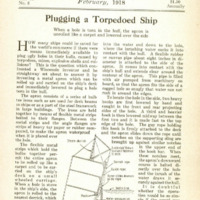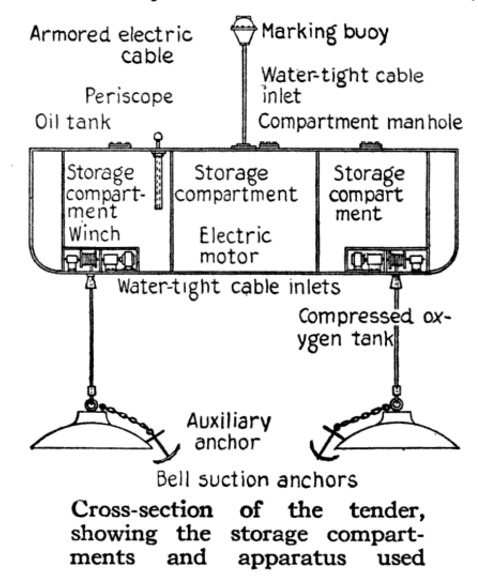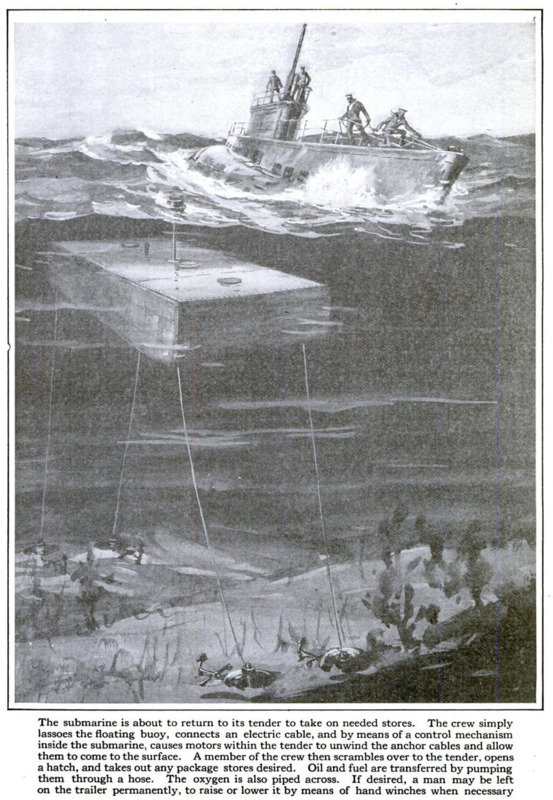Tender for supplies and fuel
Item
-
Title (Dublin Core)
-
Tender for supplies and fuel
-
Article Title and/or Image Caption (Dublin Core)
-
Supplying Submarines by Trailer. Carrying fuel and supplies in a tender, a submarine is made lighter and more mobile
-
extracted text (Extract Text)
-
UTOMOBILES have trailers, motor
trucks have trailers—why not sub-
marines? Apparently acting on
such an idea, Philippo L. E. del Fungo-
Giera, of New York city, has patented a
tender or trailer which submarines may
frisk over the high seas as unconcernedly
as a farmer hauls his milk cans in a two-
wheeled vehicle behind his Ford.
The tender, which is about thirty feet
long, can be submerged
a convenient distance
from the field of opera-
tion and thus concealed
from the enemy. In
it, fuel supplies, com-
pressed oxygen, oil
and other stores are
carried. ‘When the
submarine runs out of
such necessaries it can
return to the tender
and renew its store.
The frequent long trips
to and from a naval
base are largely elimi-
nated.
Of interest about an
invention of this kind
is the fact that while
~ the Allies might use it, it is improbable
that the Germans could. The North Sea
is patrolled by several thousand subma-
rine-chasers of various types for which
reason it seems unlikely that the Germans
could use the idea.
Upon approaching the scene of action
the submarine vessel would attempt to
reach shallow water if possible. There
she would submerge and anchor the
tender. For this purpose an armored
cable connects the electrical machinery
within the tender with the controlling
mechanism inside a marking buoy above.
The crew unbolt the cover of the buoy,
insert an electric plug which is connected
with the submarine’s dynamos, and turn
on the current. Four anchor cables are
released instantly. Electric motors drive
the four winches which partially wind up
their respective cables again. The tender
is thus made to sink to the desired depth,
while the buoy cables automatically pay
out a corresponding amount. After con-
cealing the marking buoy with seaweed,
observations are taken to determine its
position, and the submarine proceeds
upon its way. :
Allied submarines which operate in the
Baltic sea, perhaps a thousand miles from
their naval bases, ordinarily have to spend
a week's time In travel-
ing to the scene of
action and returning.
Fuel and provisions are
used up so rapidly that
the submarines have
little more than a week
and a half in which to
raid Germany's ships.
However, advocates of
the new invention be- |
lieve tenders are capa-
ble of improving this
situation. While pull-
ing a trailer may slow
up a submarine’s prog- |
ress to and from bases
somewhat, this is made
up for by the longer
time the store of sup-
plies brought along permits the craft to
stay at sea. It would clearly be out of
the question to haul supply tanks through
the North Sea, around the north of Scot-
land, and to plant them in the Atlantic
Ocean itself.
Obtaining supplies from the tender is
accomplished by first manipulating the
anchor cables in such a way that the craft
may rise to the surface. Then one of the
crew opens and enters a manhole, after-
ward taking out through this opening any
package stores the submarine may desire.
The stored oxygen, which is used for
breathing when the submarine travels
under water, is discharged into the sub-
marine by means of suitable hose con-
nections. The oils are likewise pumped
across through hose. A man may be
left permanently on the tender to lower
it still farther if in danger.
-
Language (Dublin Core)
-
eng
-
Date Issued (Dublin Core)
-
1918-02
-
pages (Bibliographic Ontology)
-
186-187
-
Rights (Dublin Core)
-
Public Domain (Google digitized)
-
Archived by (Dublin Core)
-
Filippo Valle
-
Alberto Bordignon (Supervisor)
 Popular Science Monthly, v. 92, n. 2, 1918
Popular Science Monthly, v. 92, n. 2, 1918





